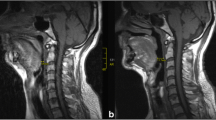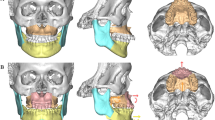Abstract
Introduction
Maxillomandibular advancement (MMA) has been reported to be the most effective surgical treatment of obstructive sleep apnea (OSA). Most reports about MMA aim to confirm the efficiency of this treatment modality, but few describe the anatomical changes produced in the pharynx by the surgery. Thus, the objective of the present investigation was to quantify the anatomical changes of the pharynx that occur in patients with OSA after MMA surgery using magnetic resonance (MR).
Methods
Twenty patients with a polysomnographic diagnosis of OSA participated in the study. All patients were submitted to image acquisition by MR performed during wakefulness. Polysomnography and MR were performed preoperatively and 6 months after MMA. Volume analysis (in cubic millimeters) was performed as the sum of the areas multiplied by their thickness, with no intervals between sections. The pharyngeal air space of the region between the hard palate and the base of the epiglottis was divided into a retropalatal (RP) region and a retrolingual (RL) region.
Results
Postoperative MR showed a mean volumetric increase of 26.72 % in the RP region and of 27.2 % in the RL region.
Discussion
MMA increases the air space of the pharynx by expanding the facial skeletal structure to which the soft tissues of the pharynx and tongue are fixed, with a consequent reduction of collapsibility in the presence of negative pressure during inspiration. This reduced possibility of pharyngeal collapse may contribute to the reduction of obstructive events.




Similar content being viewed by others
References
Baik UB, Suzuki M, Ikeda K, Sugawara J, Mitani H (2002) Relationship between cephalometric characteristics and obstructive sites in obstructive sleep apnea syndrome. Angle Orthod 72:124–134
Donnelly LF, Surdulescu V, Chini BA, Casper KA, Poe SA, Amin SR (2003) Upper airway motion depicted at cine MR imaging performed during sleep: comparison between young patients with and those without obstructive sleep apnea. Radiology 227:239–245
Faber CE, Grymer L (2003) Available techniques for objective assessment of upper airway narrowing in snoring and sleep apnea. Sleep Breath 7:77–86
Daniel MM, Lorenzi MC, Leite CC, Lorenzi-Filho G (2007) Pharyngeal dimensions in healthy men and women. Clinics 62:5–10
Strauss RA, Burgoyne CC (2008) Diagnostic imaging and sleep medicine. Dent Clin North Am 52:891–915
Stuck BA, Maurer JT (2008) Airway evaluation in obstructive sleep apnea. Sleep Med Rev 12:411–436
Segal Y, Malhota A, Pillar G (2008) Upper airway length may be associated with the severity of obstructive sleep apnea syndrome. Sleep Breath 12(4):311–316
Aihara K, Oga T, Harada Y, Chihara Y, Handa T, Tanizawa K, Watanabe K, Hitomi T, Tsuboi T, Mishima M (2011) Analysis of anatomical and functional determinants of obstructive sleep apnea. Sleep Breath. doi:10.1007/s11325-011-0528-7
Schwab RJ (2001) Imaging for the snoring and sleep apnea patient. Dent Clin North Am 45:759–795
Riley RW, Powell NB, Li KK, Troell RJ, Guilleminault C (2000) Surgery and obstructive sleep apnea: long-term clinical outcomes. Otolaryngol Head Neck Surg 122:415–421
Riley RW, Powell NB, Guilleminault C (1986) Maxillary, mandibular, and hyoid advancement: an alternative to tracheostomy in obstructive sleep apnea syndrome. Otolaryngol Head Neck Surg 94:584–588
Waite PD, Wooten V, Lachner J, Guyette RF (1989) Maxillomandibular advancement surgery in 23 patients with obstructive sleep apnea syndrome. J Oral Maxillofac Surg 47:1256–1261
Riley RW, Powell NB (1990) Maxillofacial surgery and obstructive sleep apnea syndrome. Otolaryngol Clin North Am 23:809–826
Riley RW, Powell NB, Guilleminault C (1993) Obstructive sleep apnea syndrome: a surgical protocol for dynamic upper airway reconstruction. J Oral Maxillofac Surg 51:742–747
Hochban W, Brandenburg U (1994) Morphology of the viscerocranium in obstructive sleep apnea syndrome—cephalometric evaluation of 400 patients. J Craniomaxillofac Surg 22:205–213
Guyetet RF, Waite PD (1995) Adjunctive surgical procedures in obstructive sleep apnea. Oral Maxillofac Surg Clin North Am 7:301–310
Waite PD, Shetar SM (1995) Maxillomandibular advancement surgery: a cure for obstructive sleep apnea syndrome. Oral Maxillofac Surg Clin North Am 7:327–336
Sher AE, Schechtman KB, Piccirillo JF (1996) The efficacy of surgical modifications of the upper airway in adults with obstructive sleep apnea syndrome. Sleep 19:156–177
Betetga G, Pépin JL, Deschaux C, Raphaël B, Lévy P (2000) Obstructive sleep apnea syndrome. Fifty-one consecutive patients treated by maxillofacial surgery. Am J Respir Crit Care Med 162:641–649
Hendler BH, Costello BJ, Silverstein K, Yen D, Goldberg A (2001) A protocol for uvulopalatopharyngoplasty, mortised genioplasty, and maxillomandibular advancement in patients with obstructive sleep apnea: an analysis of 40 cases. J Oral Maxillofac Surg 59:892–897
Goh YH, Lim KA (2003) Modified maxillomandibular advancement for the treatment of obstructive sleep apnea: a preliminary report. Laryngoscope 113:1577–1582
Prinsell JR (2000) Maxillomandibular advancement (MMA) in a site-specific treatment approach for obstructive sleep apnea: a surgical algorithm. Sleep Breath 4(4):147–154
Ratuner R, Obwegeser HL (1957) The surgical correction of mandibular prognathism and retrognathia with consideration of genioplasty. Oral Surg Oral Med Oral Pathol 10:677–689
Hochban W, Brandenburg U, Peetr JH (1994) Surgical treatment of obstructive sleep apnea by maxillomandibular advancement. Sleep 17:624–629
American Academy of Sleep Medicine Task Force (1999) Sleep-related breathing disorders in adults: recommendations for syndrome definition and measurement techniques in clinical research. Sleep 22:667–689
Abramson ZR, Susarla S, Tagoni JR, Kaban L (2010) Three-dimensional computed tomographic analysis of airway anatomy. J Oral Maxillofac Surg 68:363–371
Prinsell JR (1999) Maxillomandibular advancement surgery in a site-specific treatment approach for obstructive sleep apnea in 50 consecutive patients. Chest 116:1519–1529
Li K, Powell N, Riley R, Rtoell RJ, Guilleminault C (2000) Long-term results of maxillomandibular advancement surgery. Sleep Breath 4:137–139
Smatt Y, Ferri J (2005) Retrospective study of 18 patients treated by maxillomandibular advancement with adjunctive procedures for obstructive sleep apnea syndrome. J Craniofac Surg 16:770–777
Hoekema A, De Lange J, Setgenga B, De Bont LG (2006) Oral appliances and maxillomandibular advancement surgery: an alternative treatment protocol for the obstructive sleep apnea-hypopnea syndrome. J Oral Maxillofac Surg 64:886–891
Barrera JE, Powell NB, Riley RW (2007) Facial skeletal surgery in the management of adult obstructive sleep apnea syndrome. Clin Plast Surg 34:565–573
Li KK (2003) Surgical management of obstructive sleep apnea. Clin Chest Med 24:365–370
Lin HC, Friedman M, Chang HW, Gurpinar B (2008) The efficacy of multilevel surgery of the upper airway in adults with obstructive sleep apnea-hypopnea syndrome. Laryngoscope 118:902–908
Li KK (2011) Maxillomandibular advancement for obstructive sleep apnea. J Oral Maxillofac Surg 69:687–694
Dekeister C, Lacassagne L, Tiberge M, Montemayor T, Migueres M, Paoli JR (2006) Prise en charge par chirurgie d’avancée des maxillaires des patients porteurs d’un syndrome d’apnées du sommeil severe en échec d’un traitement par pression positive continue: etude retrospective de 25 patients entre 1998 et 2004. Rev Mal Respir 23:430–437
Holty JEC, Guilleminault C (2010) Maxillomandibular advancement for the treatment of obstructive sleep apnea: a systematic review and meta-analysis. Sleep Med Rev 14(5):287–297
Dattilo DJ, Droogner SA (2004) Outcome assessment of patients undergoing maxillofacial procedures for the treatment of sleep apnea: comparison of subjective and objective results. J Oral Maxillofac Surg 62:164–168
Lye KW (2008) Effect of orthognathic surgery on the posterior airway space (PAS). Ann Acad Med Singapore 37:677–682
Chuang LP, Chen NH, Li HY, Lin SW, Chou YT, Wang CJ, Liao YF, Tsai YH (2009) Dynamic upper airway changes during sleep in patients with obstructive sleep apnea syndrome. Acta Otolaryngol 129(12):1474–1479
Yu CC, Hsiao HD, Lee LC, Yao CM, Chen NH, Wang CJ, Chen YR (2009) Computational fluid dynamic study on obstructive sleep apnea syndrome treated with maxillomandibular advancement. J Craniofac Surg 20:426–430
Chan ASL, Sutherland K, Schwab RJ, Zeng B, Petocz P, Lee RWW, Darendeliler MA, Cistulli PA (2010) The effect of mandibular advancement on upper airway structure in obstructive sleep apnoea. Thorax 65:726–732
Choi JK, Hur YK, Lee JM, Clark GT (2010) Effects of mandibular advancement on upper airway dimension and collapsibility in patients with obstructive sleep apnea using dynamic upper airway imaging during sleep. Oral Surg Oral Med Oral Pathol Oral Radiol Endod 109(5):712–719
Abramson Z, Susarla SM, Lawler M, Bouchard C, Troulis M, Kaban LB (2011) Three-dimensional computed tomographic airway analysis of patients with obstructive sleep apnea treated by maxillomandibular advancement. J Oral Maxillofac Surg 69:677–686
Fairburn SC, Waite PD, Vilos G, Harding SM, Bernreuter W, Cure J, Cherala S (2007) Three-dimensional changes in upper airways of patients with obstructive sleep apnea following maxillomandibular advancement. J Oral Maxillofac Surg 65:6–12
Lan Z, Itoi A, Atkashima M, Oda M, Tomoda K (2006) Difference of pharyngeal morphology and mechanical property between OSAS patients and normal subjects. Auris Nasus Larynx 33:433–439
Conflict of interest
The authors declare that they have no conflict of interest.
Author information
Authors and Affiliations
Corresponding author
Additional information
The research was carried out at the Integrated Center of Study of Facial Deformities (CIEDEF), University Hospital, Faculty of Medicine of Ribeirão Preto, University of São Paulo, Brazil. The research protocol was approved by the Research Ethics Committee of the University Hospital of Ribeirão Preto (HCRP) and of the Faculty of Medicine of Ribeirão Preto, Universidade de São Paulo (FMRP-USP), protocol no. HCRP 6245/2006.
Rights and permissions
About this article
Cite this article
Faria, A.C., da Silva-Junior, S.N., Garcia, L.V. et al. Volumetric analysis of the pharynx in patients with obstructive sleep apnea (OSA) treated with maxillomandibular advancement (MMA). Sleep Breath 17, 395–401 (2013). https://doi.org/10.1007/s11325-012-0707-1
Received:
Revised:
Accepted:
Published:
Issue Date:
DOI: https://doi.org/10.1007/s11325-012-0707-1




